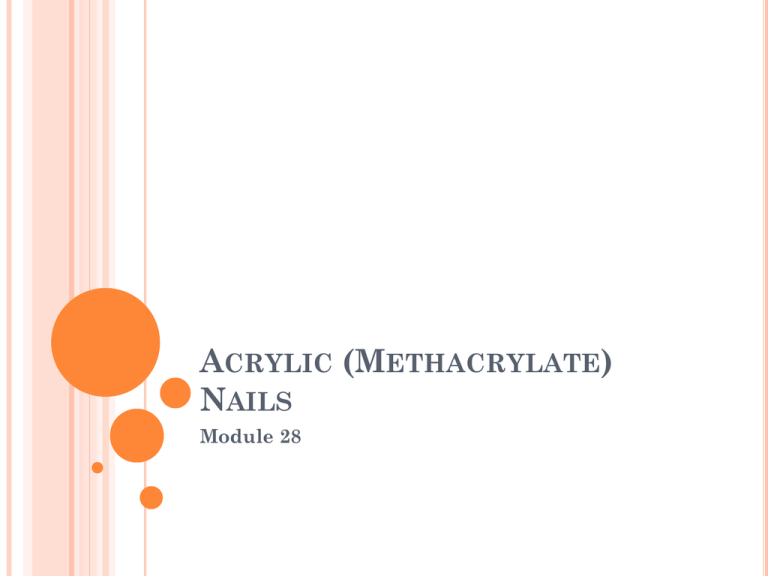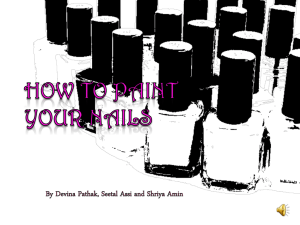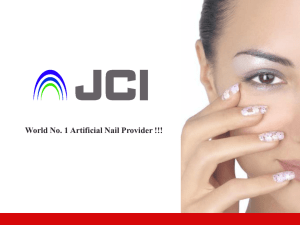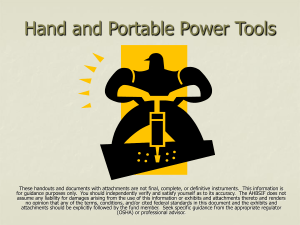Acrylic (Methacrylate) Nails
advertisement

ACRYLIC (METHACRYLATE) NAILS Module 28 EDITOR’S NOTE All artificial nail enhancements products are based on ingredients from the acrylic family Sub-branch called “methacrylate” Two-part liquid and powder enhancement systems “Acrylic” – general term for large group of ingredients Liquid and powder artificial nail enhancements products based on the methacrylate subcategory Two-part liquid and powder enhancement system referred to as acrylic (methacrylate) nails INTRODUCTION Acrylic (methacrylate) nail enhancements created by combining: monomer liquid polymer powder Liquid and powder system MONOMER “Mono” means “one” “Mer” stands for “units” Monomer is one unit called a “molecule” POLYMER “Poly” means “many “Mer” stands for “units” Polymer means “many units” or “many molecules” “LIQUID AND POWDER NAIL ENHANCEMENTS” Applied Natural nail as protective overlay Over nail tip Sculpted to extend natural nail using a flexible form Natural three basic ways hair brush best to apply products Sable is best Brush immersed in monomer liquid Natural hair bristles absorb and hold monomer like a reservoir Tip of brush touched to surface of dry polymer powder Monomer absorbs polymer – small bead is formed Bead is carefully placed on the nail surface and molded into shape with brush Liquid is usually made from ethyl methacrylate monomer Can contain other monomers used as customizing additives Polymer powder is also made ethyl methacrylate monomer Polymer powder is made using a special chemical reaction called polymerization Process Trillions of monomers linked together to create long chains Long chains create tiny beads of polymer used to create certain types of artificial nails Special additives blended into both liquid and powder Ensure complete set or cure Maximum durability Color stability Shelf life Liquid is picked up by brush and mixed with the powder Bead forms on the end of brush and quickly hardens To happen special additives called catalysts Catalyst Additive designed to speed up chemical reactions Added to monomer liquid Used to control the set or curing time Monomer liquid and polymer powder combined the catalyst helps control the set-up or hardening time Energizes and activates the initiators Initiators start a chain reaction that leads to the creation of fantastically long polymer chains Polymerization process begins the second the liquid in the brush picks up powder from the container and forms a bead Dominos INITIATOR Added to polymer is called benzoyl peroxide (BPO) Over the counter acne medicine Different purpose in nail enhancements BPO used to start chain reaction that leads to curing (hardening) Some monomers require more BPO than others Use polymer powder designed for use with monomer liquid Using wrong powder can create enhancements that are not properly cured Could increase risk of client developing skin sensitivity or irritation ACRYLIC (METHACRYLATE) NAIL ENHANCEMENTS USING FORMS Polymer powders Many colors Basic pink White Clear Natural Used alone Customized colors – blended Shades of pink Match or enhance nail beds Bold primaries Pastels Wide range of designs and patterns SUPPLIES FOR ACRYLIC (METHACRYLATE) NAIL ENHANCEMENTS Acrylic (methacrylate) nail enhancements created by combining acrylic (methacrylate) monomer liquid with polymer powder Acrylic (methacrylate) monomer liquid Here’s a tip pp 753 / 901 MIX RATIO Amount of monomer liquid and polymer powder used to create a bead “Dry Bead” Equal “Wet amounts of liquid and powder Bead” Twice as much liquid as powder “Medium Bead” 50% more liquid than powder Ideal mix ratio Typically ensures proper set and maximum durability of enhancements Too much powder Brittleness discoloration Too little powder Weak Risk developing skin irritation and sensitivity ACRYLIC (METHACRYLATE) POLYMER POWDER Choose color depends on methods used NAIL DEHYDRATOR Apply liberally to natural nail plate only Avoid skin contact Remove surface moisture and tiny amounts of oil Both can block adhesion Here’s a tip pp 753 NAIL PRIMER Acid-based primers (methacrylic acid) Corrosive to skin Potentially dangerous to eyes Not used much nowadays “Acid free” and “nonacid” primer developed in wide use today Caution box pp 754 Read mfg directions Refer to MSDS for safe handling recommendations and instructions ACID-BASED PRIMERS Relatively dry brush Using a light dotting action Carefully dab the brush tip to center of properly prepared nail Primer will spread out and cover nail plate Avoid product running into skin Causing burns/injuries Read mfg. suggested use and precautions NON-ACID AND ACID-FREE NAIL PRIMERS Slightly damp brush Ensure nail plate is completely covered Avoid too much product Running onto skin Causing skin irritation/sensitivity Treat 2 -3 nails before dipping back into container Read mfg suggested application procedures and precautions ABRASIVES Medium grit 180 – 240 Natural nail prep and shaping Smoothing Fine grit 350 or higher buffing 3 way buffer Create shine for no polish Coarser grit Lower grit Avoid using Can damaged fresh nail enhancement Acrylics strength can take 24 – 48 hours till peak NAIL FORMS Placed under free edge Used to extend nail enhancements beyond fingertip Creates additional strength Extra boxes on PP 902 - 903 NAIL TIPS Pre-formed extensions Wide variety Shapes Styles colors NAIL ADHESIVE Cyanoacrylate monomers Each types uses different customized additives to enhance Set times Strength Other properties Small size bottle Short shelf life 6 months after date of purchase Depends on storage and usage Obtain maximum shelf life Close cap securely Set upright Store out of direct sunlight Room temperature - 60º - 85º Nail adhesive may harden in tube and need to be thrown away DAPPEN DISH Poured into special holder Monomer Polymer Small narrow openings – minimize evaporation Do not use open-mouthed jars or containers with large openings Must be covered with a tightly fitting lid when not in use NEVER pour unused portion back into original container contaminated Avoid skin contact with monomer to avoid skin sensitivity or irritation Wipe clean with acetone Store in a dust free location NAIL BRUSH Sable hair Synthetic/less expensive brushes do not pick up monomer or do not release liquid properly Avoid overly large brushes – Hold excessive amount of liquid Risk touching client’s skin with monomer May increase risk of developing skin irritation or sensitivities SAFETY EYEWEAR Protect eyes from flying objects Accidental splashes DUST MASKS AND PROTECTIVE GLOVES Dust masks Worn over nose/mouth to prevent inhalation off excessive amounts of dust Provide NO protection from vapors Gloves ACRYLIC (METHACRYLATE) NAIL ENHANCEMENTS PRE-SERVICE Complete pre-service sanitation and disinfection procedure (ch. 25, pp 672/817) Wash implements Rinse implements Immerse implements Wash hands with liquid soap Rinse and dry implements Set up standard manicuring table Greet client and direct to wash hands with liquid soap and warm water Perform client consultation APPLICATION OF ACRYLIC (METHACRYLATE) NAIL ENHANCEMENTS USING FORMS Pages 757 – 761 FYI pp 762 Pages 912 - 915 ACRYLIC (METHACRYLATE) NAIL ENHANCEMENTS POST-SERVICE Make another appointment Take-home product recommendation Clean up around table Clean brush Store acrylic products Discard used materials Clean table - clean and disinfect implements and multiuse tools ACRYLIC (METHACRYLATE) NAIL ENHANCEMENTS OVER NAIL TIPS OR NATURAL NAILS Pages 763 – 766 Caution box pp 766 Pages – 908 - 911 MAINTENANCE AND REMOVAL OF ACRYLIC (METHACRYLATE) NAIL ENHANCEMENTS Regular maintenance prevents nail enhancements from lifting or cracking If lifting/breaking greater risk of infection and other problems Full and proper rebalance must be performed every 2 – 3 weeks REBALANCING Method for maintaining the beauty, durability, and longevity of artificial nail enhancements Do not let clients go too long without proper rebalance - more repairs Nail is thinned down –apex of nail removed – entire nail enhancement reduced in thickness Procedure pages 768 – 769 / 916 - 918 Caution box page 769 / 917 CRACK REPAIR Addition of enhancement product to repair cracks Similar procedure to rebalance Procedures – page 770 / 919 - 920 REMOVAL Perform as soon as possible after request is made Procedure pp 771 921 - 922 Condition surrounding skin with nail oil/lotion ODORLESS ACRYLIC (METHACRYLATE) PRODUCTS Same chemistry as all other monomer liquid and polymer powder Instead of using ethyl acrylic (methacrylate) – rely on monomers with little odor Must be used with a dry ix ratio If Equal parts liquid to powder in bead too wet – skin irritation /sensitivity “snowy – appearing” bead on brush Lift brush and tap gently to remove excess powder Never rewet the brush with monomer Will dilute the enhancement product already placed on nail Create wrong mix ratio Odorless harder more slowly Creates tacky layer - “inhibition” layer After hardening – remove using alcohol, acetone or mfg. product Can be filed away Avoid skin contact COLORED ACRYLIC (METHACRYLATE) POWDERS Limited only by your imagination Maintain recipe cards so they can be reproduced Create customized nail enhancements Pay a few dollars more for the special service






